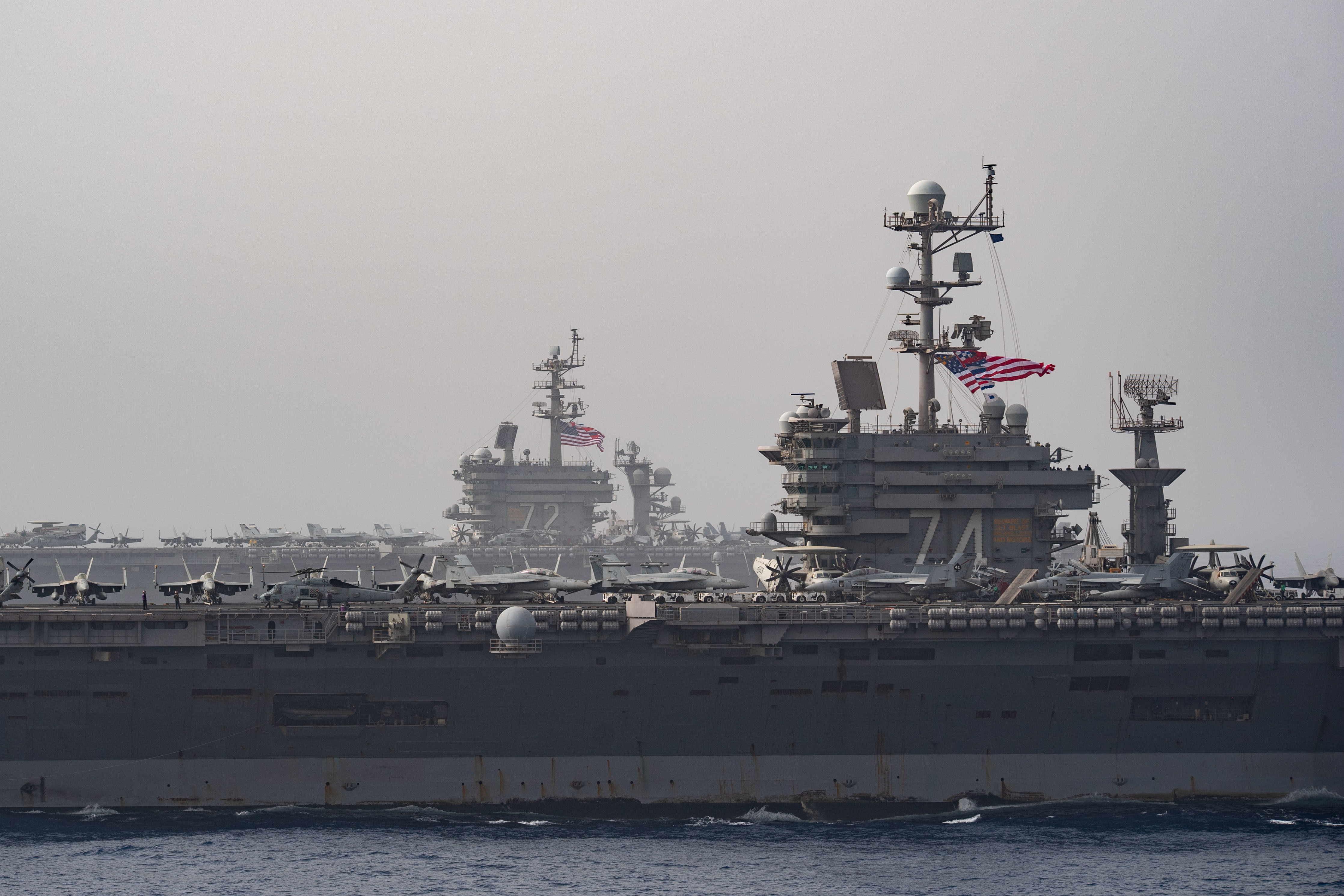
The Navy and Marine Corps plan to conduct a large scale exercise involving multiple strike groups and multiple numbered fleets next year, after the original plans for a Large Scale Exercise 2020 this year were postponed due to the ongoing coronavirus pandemic.
The chief of naval operations and commandant of the Marine Corps said today that Large Scale Exercise 2021 would be the first major live test of the Distributed Maritime Operations (DMO), Littoral Operations in a Contested Environment (LOCE) and Expeditionary Advance Base Operations (EABO) concepts that are driving the bulk of their ongoing budget and acquisition decisions.
“We want to take a deeper look at DMO, LOCE, EABO and how they tie together. And so that’s important for us conceptually to ensure those concepts in a way we can visualize whether or not we need to course-correct, whether or not we’re headed precisely in the right direction,” CNO Adm. Mike Gilday said today while speaking at the U.S. Naval Institute’s annual Defense Forum Washington event.
Gilday said he couldn’t publicly talk about which units would participate or exactly how many ships and personnel would be involved. But he said that the event, which will take place in the summer, will involve multiple carrier strike groups and multiple amphibious ready groups – putting this exercise at a scale not seen in recent history.
Gilday said last year that LSE would not only test the DMO concept but would also be the first live exercise to include small tactical cyber teams and information warfare cells, acknowledging that the Navy will have to defend against and leverage offensively new space, cyber and information domains.
Gilday did not address the cyber teams today but did say that LSE 2021 would stress the ability to integrate assets from the sea bed to space and would tie together assets across geographical fleet lines.
“We’re likely going to be in a fight next that’s going to be trans-regional, and it’s certainly going to be all-domain,” he said.
Commandant Gen. David Berger, who spoke alongside Gilday, said that the Navy and Marine Corps had conducted plenty of exercises that focused on smaller-scale conflict that could be contained to a particular geographic area, “but against a peer adversary, there’s a clear acknowledgement that you’re probably not going to be able to contain it into a local, small region – which drives you towards multiple numbered fleets, multiple [Marine Expeditionary Forces]. The Large Scale Exercise is going to go beyond a single numbered fleet and a single MEF; it’s going to tie together, stitch together multiple fleets, multiple MEFs, on more of a globally integrated scale.”
In stretching out the battle, Gilday said, the logistics and sustainment models will be stressed, which is an area the Navy and Marine Corps intend to spend time addressing in 2021.
“We wargame and we study logistics all the time, but we never have developed really a plan for sustaining the fleet in a fight. And so that’s an important project for us in 2021, to actually develop a plan for how we sustain a fleet – not just logistics, but battle damage. We just, we haven’t been forced, we haven’t forced ourselves to take a deeper look in terms of a plan, and we need one,” the CNO said.
In a later panel, Naval Sea Systems Command chief Vice Adm. Bill Galinis was asked about the Navy’s battle damage capabilities and crews’ self-sufficiency while operating at sea. Galinis said crews had shown in recent incidents that they were good at initial damage control effort, but there’s work to do on the subsequent battle damage assessment and expeditionary repair efforts.
Galinis noted that the COVID-19 pandemic has reduced NAVSEA’s ability to send technicians out to ships to help fix broken gear, so the crews have had to get better at keeping themselves ready for tasking without outside help. He said the type commanders would be looking for ways to further boost self-sufficiency, since it’s unlikely that flyaway repair teams would be able to make it out to a ship at sea during a fight in a contested space.
He added that NAVSEA is looking at improved training for maintenance sailors, as well as enterprise-wide ideas for repairing battle damage: “if we had to bring a surface ship into a naval shipyard, for example, we could do that. Or if we had a flyaway team from maybe a private shipyard to help on an aircraft carrier, for example.”
Gilday and Berger also addressed the role of unmanned systems in Large Scale Exercise 2021 and other upcoming events as they learn what DMO, LOCE and EABO might look like when executed live.
Gilday said that all strike groups conduct Fleet Battle Problems while transiting to or from a deployment, and that some recent ones have begun to include a limited amount of unmanned systems. Due to the small scale, though, these events only address a small slice of DMO and LOCE in a specific location.
Berger said the Navy and Marine Corps needed to do a lot of experimenting with unmanned systems in a short amount of time, and to do that they may start using surrogates to play the role of unmanned surface or undersea vessels.
“We will, in exercises, start to use surrogates. In other words, manned platforms that replicate an unmanned platform so that we can learn faster instead of waiting three, four years until the unmanned platform gets here,” the commandant said.





